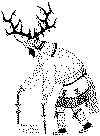
Fig. 25.
Deer Dance of San Juan
was missing text at end
This is a dance calling upon the Deer to increase, and to choose nearby stamping grounds.
On February 26, 1930, I saw a beautiful presentation of this dance at the pueblo of San Juan, New Mexico.
At dawn, the eighteen Deer came running in from the high moun_ taro about a mile back of the pueblo. They wore ordinary White man's shirts, with armbands above each elbow, some solidly beaded, some of painted buckskin, each holding in place close to the outside of the arm, a branch of evergreen. The hands were painted white. The trousers were tight-fitting to the leg, crocheted of white cotton in an openwork zigzag pattern running up and down. Over these, hanging almost to the knees, a^ch wore a white woven apron, embroidered in colors at the ends, open down the back; a white sash with long fringe, at the top of which was a row of large white covered balls; a string of bells about the waist; below each knee a garter tied in front with a long hank of colored worsted; gay colored ties about the neck loosely knotted, and many strings of beads; colored moccasins, most of them beaded, Sioux fashion, and all with a band of black skunk skin around the top.
In the right hand each carried a gourd rattle; in the left, a wand, head-high, surmounted by three feathers, the two outer ones eagle feathers, and the inner, a beautifully colored macaw or similar. These three feathers were held in place, together with a sprig of evergreen, by a white cone about four inches high. Halfway down, the wand was wound with colored cotton and a little fluff.
The headdresses were very beautiful. They were of yellow yucca stalks, each stalk about a half inch in thickness, woven close together into an upright fan, with a two-inch wide band of green painted across it three inches from the top. This arc was attached to a fabric cap, which carried also a pair of muledeer horns, tipped with gray down. The cap was tied under the chin to keep it in place. Down the back, at the shoulders, hung a half-circle of eagle feathers, tips down. The cloth which carried these, was tucked into the back of the belt. The back of the neck was painted white. (See Fig. zS.)
These eighteen Deer were headed by an old Medicine Man, with a wonderfully beautiful face. His long hair hung in
soft waves to his waist, and was topped by two eagle feathers. He wore a pair of Sioux pants, beaded down the outer seams, are ordinary shirt, and moccasins. There was a peculiar box-like arrangement tied to the back of his belt, hung
with yellow buckskin. He carried a large bunch of evergreen in his right hand, with which he directed the rhythm of the dance.
Before the approach of the Deer at dawn, there had been planted in the plaza two small evergreen trees, each about three feet high, and some thirty feet apart. The whole dance took place in a straight line between these two trees.
The Deer, one behind the other, trot-step in place to the rhythm of the song they sing, and the thumping of the one tombe. There were no words to the song, scarcely even vocables; it was a peculiar propulsion of sound in a faintly melodious air.
The long wands were held obliquely in front of each dancer by the left hand, and never left the ground during the rendition of the song; until all about-faced and repeated the music and dance in the opposite direction. The Medicine Man slowly moved with his step along the line of the dancers, always facing forward.
When the dance was about half finished, there appeared two hunters, their faces painted white and black, and dressed more or less in the manner of clowns. One wore a wide band of black fur about the forehead, with an eagle wing over each ear; the other a stockinette cap of gray, with black and white turkey feathers in a bunch at the top. Each carried a bow, and wore a quiver of arrows (really reeds). These hunters manoeuvred about, and occasionally shot one of the arrows over the head of some Deer, lightly touching the headdress of the victim.
This went on for some twenty minutes, and was repeated after a rest period.
Toward the end of the afternoon, after a pause in the dancing during which they sang in one of the houses, the dancers reappeared, each now with a short stick, about eighteen inches long, in each hand, body bent forward over these as if walking on all fours.
Suddenly, they rose up and ran, followed by the women of the pueblo. We could see them for half a mile across the desert. When caught, all returned to the pueblo. The Deer must give the woman who caught him some meat; the woman gives the Deer some flour.
Meantime, the four Deer who had been shot by the hunters, kneeled down in one place, and were addressed in loud harangue by the hunters. This was their official execution.
54